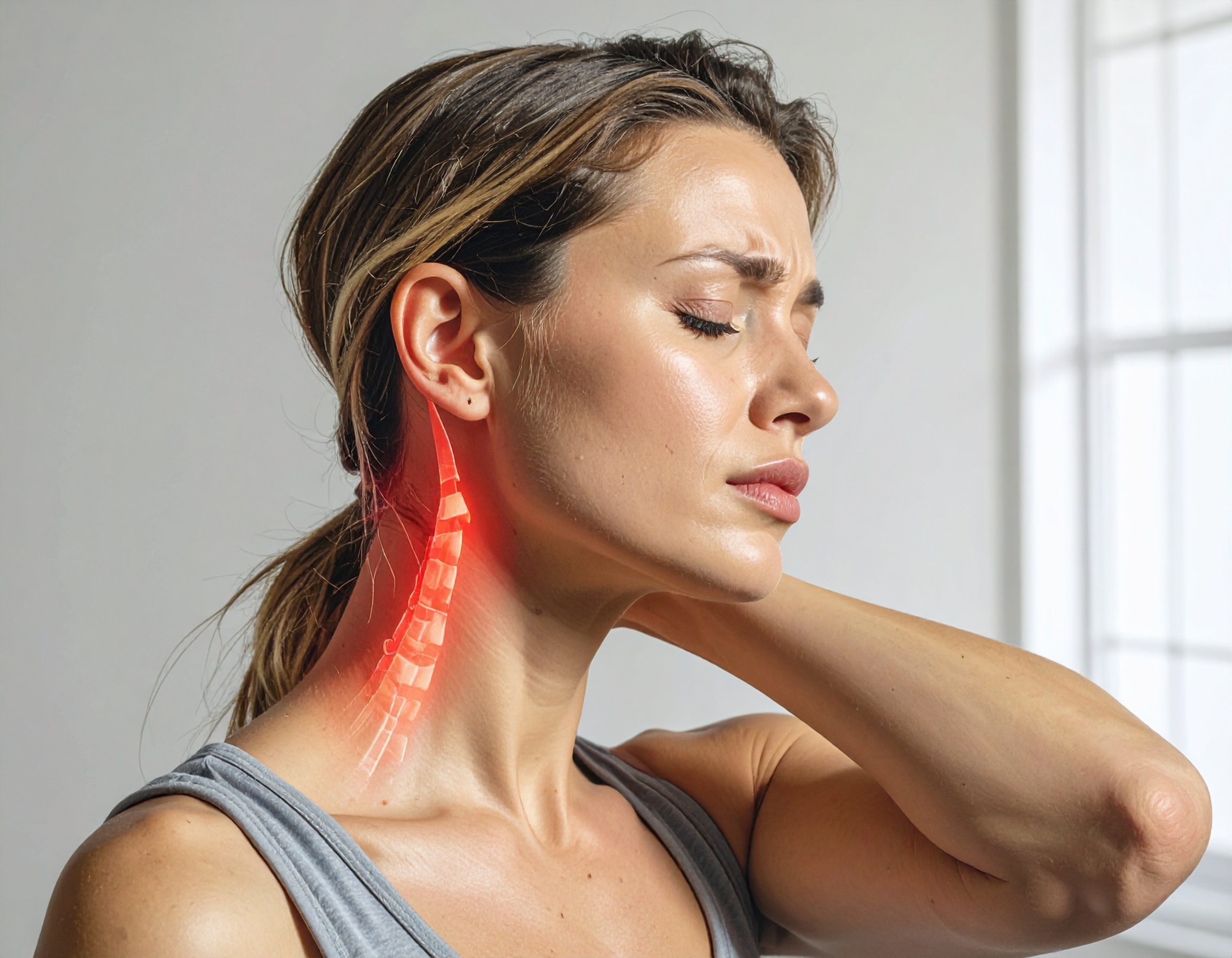Neck pain is a common condition affecting people of all ages. It may present as stiffness or sharp pain and can interfere with daily activities such as work, sleep, or movement. Neck stiffness is an important symptom that may indicate injury and should prompt you to seek care, especially if accompanied by weakness or numbness.
This guide explains the causes of neck pain, how to recognize serious symptoms, and outlines effective home and clinical treatments. Whether your pain is occasional or ongoing, you will find clear next steps here.
Understanding Neck Pain and What Causes It
The cervical spine, or neck, consists of seven vertebrae that support the head and enable a wide range of motion. Its flexibility makes it more susceptible to injury and strain.
Neck pain can affect muscles, ligaments, nerves, discs, or joints. It may result from sudden movements or develop gradually due to repetitive habits. Pain can stay localized or radiate to the shoulders, arms, or upper back, especially if nerve roots are compressed by conditions like herniated discs or bone spurs.
Neck pain may be occasional or chronic. Bone spurs and spinal canal narrowing can compress nerves, causing neurological symptoms. Identifying the cause is essential for effective treatment.
Most neck pain is caused by common issues like muscle strain, but serious causes and underlying medical conditions should be considered if symptoms persist. Understanding the cause of neck pain is essential for effective treatment and healthcare providers will look for underlying medical conditions.
Top Lifestyle and Structural Causes
The neck has a tough job. It balances your 10–12-pound head all day long. Neck injury from trauma or accidents is a common cause of neck pain. Small imbalances —The neck supports the weight of the head throughout the day. Injuries from trauma or accidents are common causes of neck pain. Poor posture or inadequate support can also gradually strain the cervical spine.put pressure on the cervical spine or nerve roots, leading to pain, numbness, or weakness.
Muscle Strain and Overuse
Poor posture is a leading contributor to neck pain. Prolonged periods of looking down or sitting with rounded shoulders can overwork neck muscles and lead to discomfort.
Repeated small movements, such as typing without arm support, can strain neck tissues. Without intervention, this tension may become chronic.
Whiplash and Trauma
Whiplash is caused by rapid forward and backward movement of the neck, commonly from auto accidents, sports, or falls.
This movement can stretch and irritate muscles, ligaments, and joints, leading to pain, stiffness, limited motion, and headaches. Symptoms may be delayed. Serious injury from whiplash or trauma requires prompt evaluation.
Degenerative Disc Disease
As we age, spinal discs lose moisture and height. This natural degeneration can lead to less shock absorption between vertebrae, resulting in stiffness, inflammation, or even nerve compression.
Degenerative changes may cause daily or chronic neck pain, especially after activity or sleep.
Herniated or Bulging Discs
A herniated disc happens when the disc’s inner gel pushes through its tough outer shell. In the neck, a herniated disc can put pressure on a nerve root or the spinal cord, leading to neurological symptoms such as pain, numbness, or tingling down the arms and into the hands.
This type of pain is often sharp, shooting, or accompanied by muscle weaThis pain is often sharp, shooting, or accompanied by muscle weakness.laptop or looking down at your phone for hours can cause “tech neck,” where the head juts forward and strains the cervical spine. Maintaining good posture is essential to prevent neck pain caused by poor ergonomics.
This position increases strain on neck joints and muscles, potentially leading to structural changes and chronic pain. Practicing good posture is key to preventing and relieving neck pain from poor ergonomics.
Emotional Stress and Muscle Tension
Emotional stress can increase muscle tension, particularly in the shoulders and neck.
This may cause tightness, tension headaches, and reduced mobility. Managing stress is important for neck pain recovery.

Recognizing the Symptoms of Neck Pain
Neck pain symptoms can range from mildly annoying to severely debilitating. While most cases resolve on their own, it’s important to know what to watch for — especially if symptoms change or intensify. Neck pain may also be accompanied by other symptoms, such as headaches or numbness, which can help identify the underlying cause.
Common Symptoms Include:
- Stiffness or soreness that worsens after sitting or sleeping
- Headaches that begin at the base of the skull
- Limited ability to turn or tilt the head
- Pain that radiates to the shoulders or upper back
- Muscle spasms or a “tight” feeling across the neck
Symptoms may worsen during activities such as driving, reading, or using a phone.
Concerning Symptoms to Monitor:
- Numbness or tingling in the arms or hands
- Loss of strength in your upper limbs
- Balance issues or coordination problems
- Pain that doesn’t improve after a week of home care
- Neck pain following a recent trauma, such as a car crash
If you experience these red flags, seek medical care to rule out more serious conditions like nerve impingement or cervical spine instability. If you have severe symptoms such as weakness, numbness, or neck pain after trauma, seek medical attention immediately.
How Neck Pain Is Diagnosed
A healthcare provider will evaluate your symptoms by:
- Taking a detailed medical history
- Asking about daily activities, sleep posture, and stress levels
- Performing a physical exam to assess motion, muscle strength, and reflexes
Neck pain is diagnosed through a combination of medical history, physical exam, and, in rare instances, additional tests.
Imaging tests such as X-rays, MRIs, or CT scans may be used to identify disc degeneration, arthritis, or herniation. Further testing is rarely needed to rule out uncommon causes.
Most cases are diagnosed without invasive testing, particularly when symptoms are mild and temporary.
Identifying the cause of neck pain is essential for selecting appropriate treatment. Some causes, such as meningitis, require immediate medical attention.
Proven Ways to Relieve Neck Pain at Home
Before turning to medical intervention, many people find success with conservative at-home treatments. These strategies are designed to relieve pain and improve function. They help reduce inflammation, ease muscle tension, and restore mobility.
Alternative therapies such as yoga or acupuncture may also provide pain relief for some individuals.
Ice and Heat Therapy
- Use ice in the first 24–48 hours to reduce swelling and numb pain.
- Apply heat after that to relax muscles and improve circulation.
Alternate as needed throughout the day for 15–20 minutes at a time.
Light Movement and Gentle Stretches
Prolonged rest can slow healing. Incorporate simple movements such as:
- Neck tilts (side to side)
- Chin tucks
- Shoulder rolls
- Gentle neck rotations
Stretch for 10–15 minutes, twice daily, avoiding sudden or jerky movements.
Postural Awareness
- Keep your ears in line with your shoulders when standing or sitting
- Adjust screens to eye level
- Use a chair with neck and lumbar support
- Avoid working in bed or on the couch for long hours
Sleep Adjustments
- Sleep on your back or side — not your stomach
- Use a pillow that supports your neck’s natural curve
- Avoid pillows that are too soft or too tall
Proper sleep alignment supports recovery and helps prevent strain during the night.
See Recommended Products

When to Call a Professional
If home treatment has not improved your neck pain after 7 to 10 days, consult a medical professional. Seek immediate care for severe, worsening, or neurological symptoms, or after trauma.
Get evaluated sooner if:
- Pain is getting worse or spreading
- You experience neurological symptoms
- Sleep or work is being regularly disrupted
Timely diagnosis and treatment can relieve neck pain, address the underlying cause, and prevent complications.
Clinical Treatments for Persistent Neck Pain
After diagnosis, your provider may recommend one or more evidence-based therapies to treat neck pain and address its underlying causes:
Physical Therapy
Physical therapists teach you exercises to:
- Strengthen deep neck stabilizers
- Improve flexibility
- Correct postural imbalances
- Reduce nerve compression
They may also use manual therapy, soft tissue work, and targeted stretches.
Chiropractic Care
Chiropractors perform gentle spinal adjustments to reduce joint restrictions and improve motion. Many also incorporate soft tissue work, ergonomic training, and home exercises.
This approach is often effective for mechanical neck pain that is not related to disc damage.
Massage Therapy
Massage techniques like myofascial release and trigger point therapy help reduce muscle tightness and improve blood flow.
Regular sessions may help relieve pain from stress, overuse, or poor posture.
Medications and Injections
If your pain is severe, your provider might suggest:
- NSAIDs (e.g., ibuprofen)
- Muscle relaxants
- Cortisone injections for inflammation
These treatments are typically used short-term alongside physical therapy or rest.
How to Prevent Neck Pain from Coming Back
Recovery involves both treatment and prevention. The following daily habits can help reduce your risk of flare-ups.
Strengthen Key Muscles
Regularly train your upper back, shoulders, and core with:
- Chin tucks
- Resistance band rows
- Shoulder blade retractions
These exercises support the spine and improve posture.
Set Up a Neck-Friendly Workspace
- Monitor at eye level
- Desk and chair height should allow arms to rest comfortably
- Consider a standing desk to reduce prolonged static postures.
Take Breaks & Manage Daily Stress
- Stand up every 30–45 minutes
- Do shoulder rolls or short walks
- Stretch during lunch or between meetings
- Deep breathing
- Gentle yoga
- Meditation
- Listening to calming music or nature sounds
Managing mental tension can help prevent physical tightness.
FAQs
How do I decompress my neck?
Start with gentle chin tucks: sit tall, draw your chin straight back (no tilt) until you feel a light stretch at the base of the skull. Hold 3–5 seconds and repeat 10 times. You can also place a rolled towel behind your neck and gently nod to relax tight muscles.
What causes neck pain?
Common causes include muscle strain from posture or screen time, joint wear-and-tear (arthritis), disc changes, and irritated nerves. Stress, poor sleep, and prior injuries can also contribute.
What is a pinched nerve in the neck?
Also called cervical radiculopathy, it happens when a nerve root is compressed or irritated—often by a disc or bone spur. Symptoms may include sharp neck pain that travels to the shoulder or arm, plus numbness or tingling.
What is whiplash?
A rapid back‑and‑forth motion of the neck (often from a car accident or sports) that can cause pain, stiffness, headaches, and reduced range of motion. Most cases improve with early, gentle movement and guided exercises.
How is a herniated disc in the neck treated?
Initial care usually includes activity modification, short‑term pain relievers (if safe for you), and physical therapy focused on posture and gradual strengthening. Injections or surgery are considered if symptoms persist or if there are significant neurological deficits.
When should I see a doctor?
Get medical help right away after serious injury or if you have arm weakness, numbness spreading into the hand, loss of coordination, severe headache, fever, or persistent pain lasting more than a few days.

